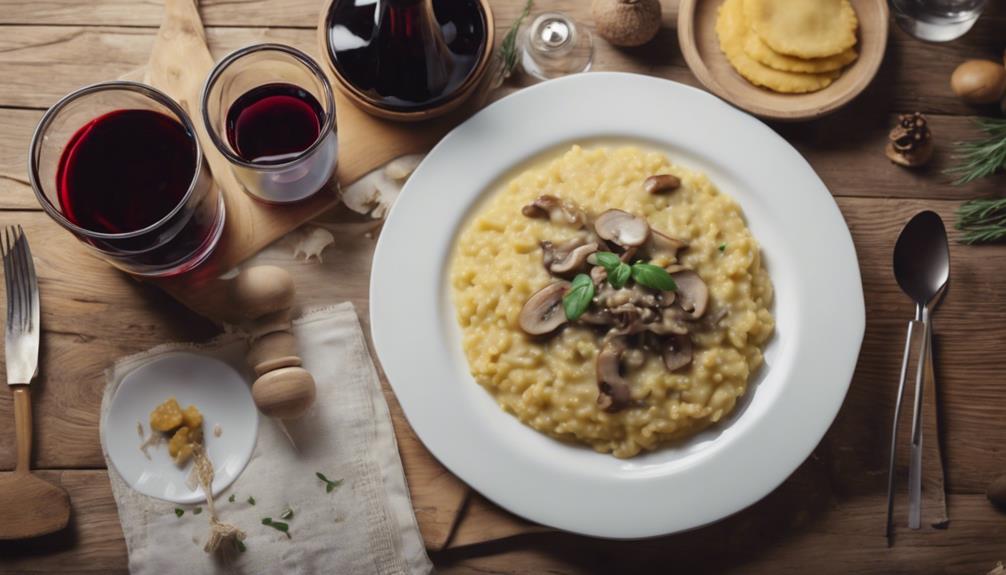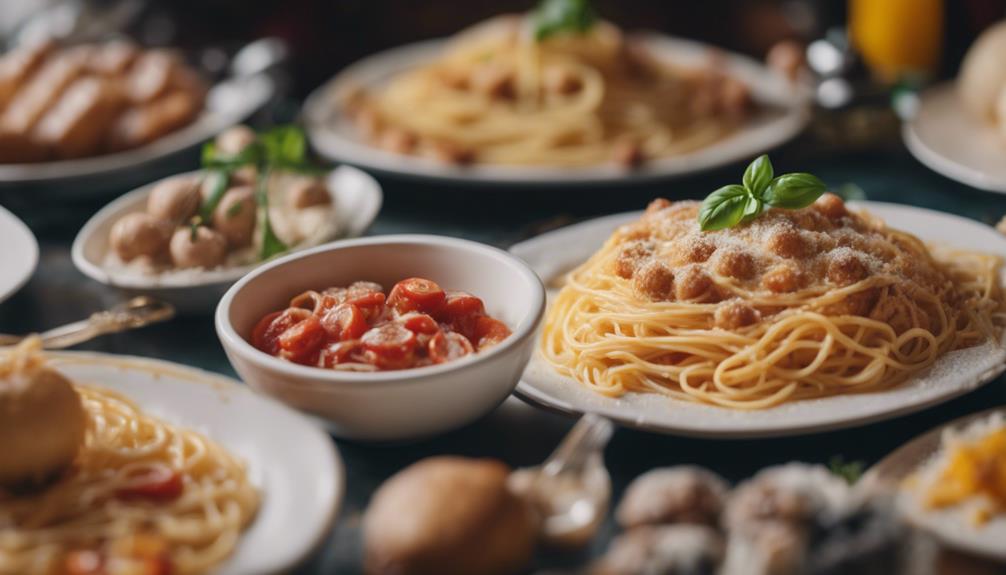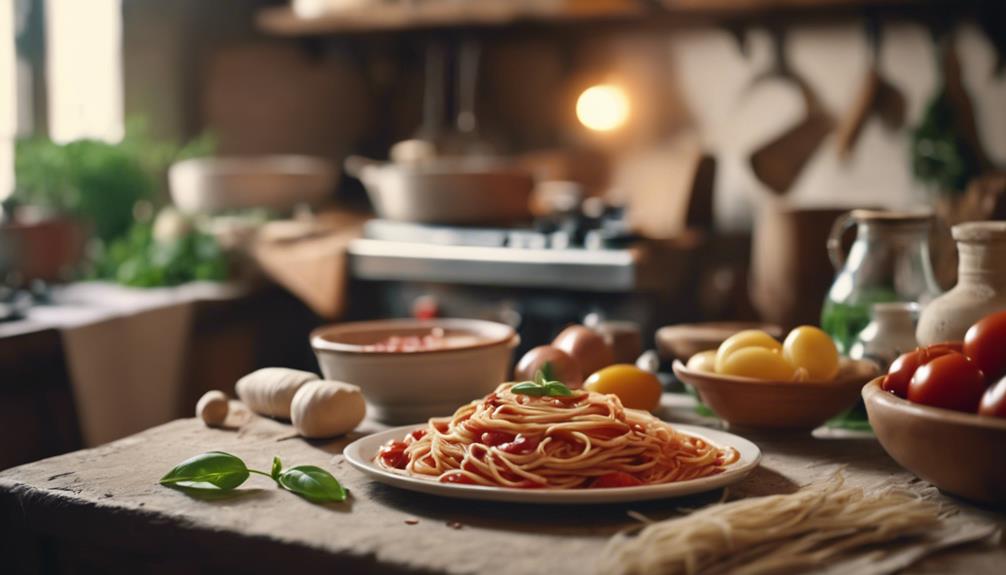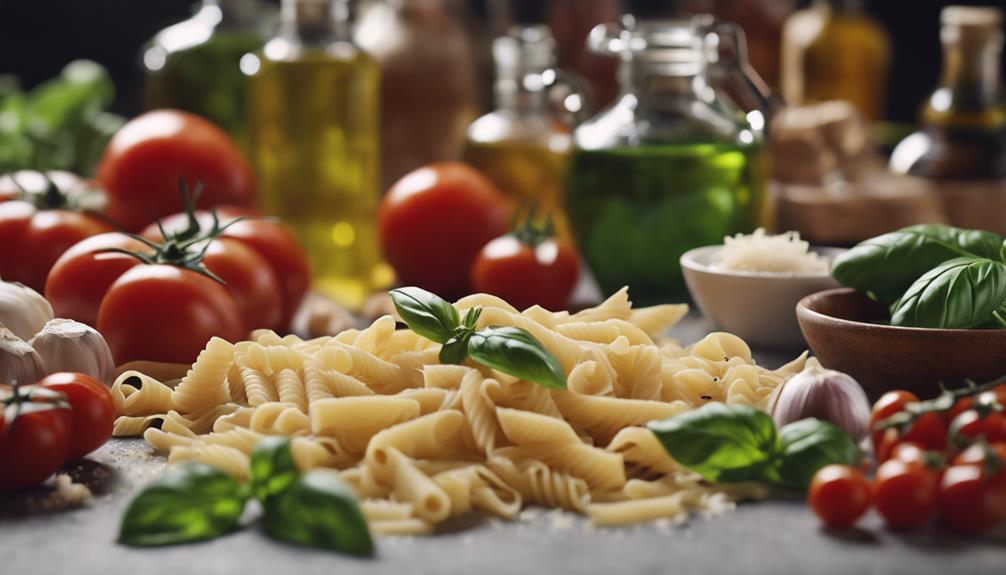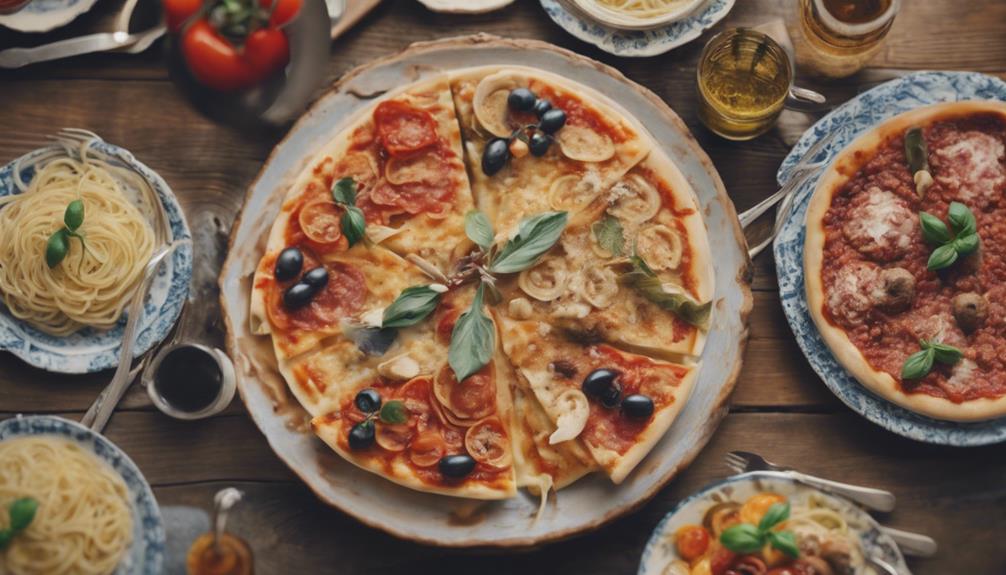Immerse yourself in the rich flavors of Northern Italian cuisine, known for its distinctive ingredients and traditional cooking methods. Staples like risotto, polenta, and Parmigiano-Reggiano cheese are emblematic of its culinary heritage. Treat yourself to dishes like osso buco, Milanese-style veal cutlets, and luscious tiramisu for an authentic taste of the region. Complement these delicious flavors with top Northern Italian wines such as Barolo or Amarone to enhance your dining experience. Explore the historical influences and modern innovations that have shaped this cuisine, and discover a world of sophisticated flavors waiting to enchant your taste buds.
Key Takeaways
- Northern Italian cuisine showcases refined flavors with fresh vegetables, dairy, white truffles, and Barolo wine.
- Regional influences from the Po Valley soil and local ingredients enrich traditional dishes.
- Culinary heritage intertwined with staple ingredients like Carnaroli rice and iconic cheeses.
- Meticulous cooking techniques highlight precision and attention to detail for balanced flavors.
- Modern trends embrace innovative techniques, global influences, and high-quality ingredients for a diverse culinary experience.
Introduction to Northern Italian Cuisine
Begin a culinary adventure through the rich flavors and traditions of Northern Italian cuisine. This region's culinary heritage is a treasure trove of delectable dishes and exquisite flavors that will transport you to the heart of Italy.
Immerse yourself in a world where handmade pasta, like Tortellini and Ravioli, takes center stage, showcasing the artistry and dedication of Northern Italian chefs. Cheese, a cornerstone of this cuisine, adds a layer of richness and complexity to dishes, with iconic varieties such as Parmigiano-Reggiano, Gorgonzola, and Fontina elevating every bite.
Explore the regional dishes that define Northern Italian cuisine, from Veal Loin Scaloppine with sautéed shallots to an array of flavorful fillings for pasta parcels. Each dish tells a story of meticulous preparation techniques passed down through generations, highlighting the craftsmanship and attention to detail that are at the core of Northern Italian cooking.
Embark on a gastronomic journey filled with rich flavors and culinary delights that celebrate the tradition and love for good food in this sophisticated and iconic cuisine.
Key Ingredients in Northern Italian Cooking
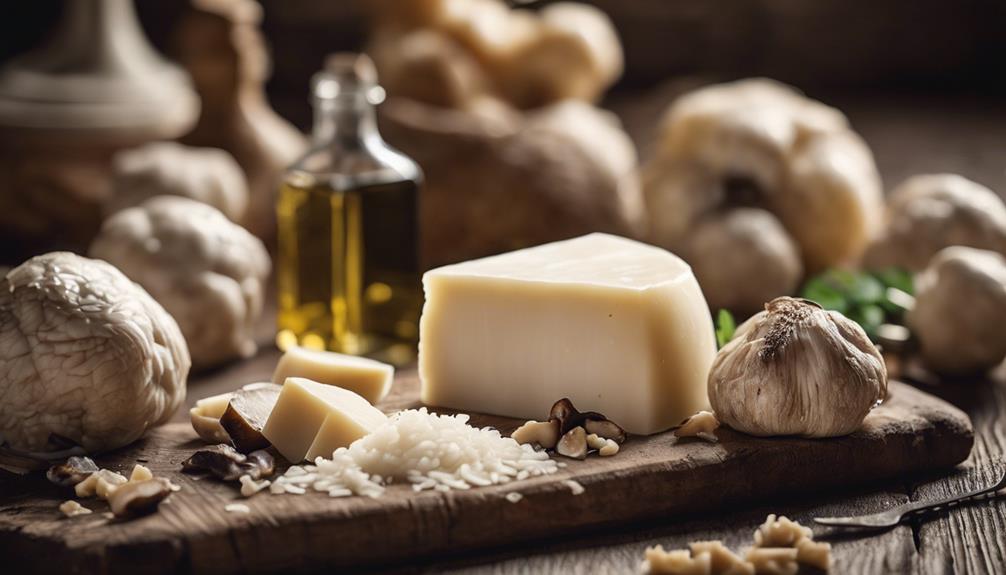
Northern Italian cuisine boasts a rich tapestry of popular ingredients like fresh vegetables, grains, and dairy sourced from the bountiful Po Valley.
Regional culinary influences infuse dishes with character, from velvety Parmigiano-Reggiano to the piquant notes of Gorgonzola.
Traditional cooking techniques, passed down through generations, form the backbone of Northern Italian gastronomy, creating a culinary legacy worth savoring.
Popular Northern Ingredients
Key ingredients in Northern Italian cooking include white truffles from Piedmont, Barolo wine, and Carnaroli rice for creamy risotto. These elements form the backbone of many traditional dishes in the region, providing a rich and distinctive flavor profile.
To truly savor the essence of Northern Italian cuisine, you must appreciate the nuances of these staple ingredients:
- White Truffles: Known for their intense aroma and earthy flavor, white truffles elevate dishes like Tagliolini al Tartufo Bianco to gourmet heights.
- Barolo Wine: Hailing from the Piedmont region, Barolo wine's robust and complex taste is perfect for hearty stews and braised meats.
- Carnaroli Rice: With its high starch content, Carnaroli rice creates a velvety texture in risotto dishes like Risotto ai Funghi Porcini.
- Parmigiano-Reggiano Cheese: Aged to perfection, this cheese adds a salty tang to dishes like Risotto ai Frutti di Mare, enhancing the overall flavor profile.
These ingredients represent the essence of Northern Italian cuisine, capturing the essence of the region's culinary heritage.
Regional Culinary Influences
The influence of the fertile Po Valley soil is evident in the abundance of fresh, local ingredients that shape Northern Italian cuisine. Each of the Northern regions contributes to the regional culinary landscape with unique flavors and cooking traditions.
From the Alpine valleys in the north to the coastal plains in the south, local ingredients like vegetables, grains, and dairy products play a vital role in defining the culinary identity of each area. Iconic dishes such as veal specialties, handmade pasta like tortellini and ravioli, and a variety of fillings for pasta parcels reflect the regional variations and culinary craftsmanship passed down through generations.
Cheese also holds a significant place in Northern Italian cuisine, with Parmigiano-Reggiano, Gorgonzola, and Fontina being pivotal ingredients that enhance the depth and complexity of dishes. As you journey through Northern Italy's gastronomic delights, you'll encounter sophisticated and iconic dishes that showcase the region's rich culinary heritage and love for good food.
Traditional Cooking Techniques
In Northern Italian cuisine, traditional cooking techniques are intertwined with key ingredients that define the region's culinary identity.
- Slow-cooking Risotto: Northern Italians take pride in their risotto, a creamy dish achieved through slow-cooking Arborio, Carnaroli, or Vialone Nano rice.
- Fresh Local Ingredients: The cuisine thrives on the use of fresh local ingredients like white truffles, Barolo wine, and Parmigiano-Reggiano cheese, enhancing the dishes' flavors and authenticity.
- Aged Balsamic Vinegar: A staple in Emilia-Romagna, aged balsamic vinegar undergoes a meticulous process in wooden barrels, resulting in sweet to tangy flavor profiles ideal for various dishes, from salads to desserts.
- Pumpkin-filled Pasta (Ravioli di Zucca): A beloved dish in Northern Italy, Ravioli di Zucca features pumpkin-filled pasta crafted with roasted pumpkin, served with a decadent butter and sage sauce, showcasing the region's love for seasonal ingredients and intricate pasta-making.
Popular Northern Italian Dishes
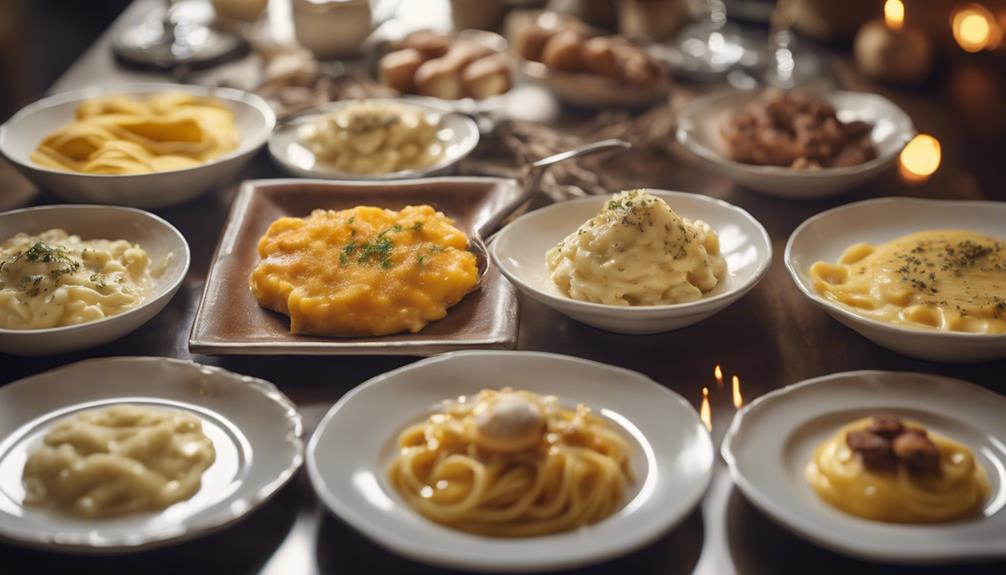
Northern Italian dishes are known for their rich flavors and culinary influences apparent in each bite. From the iconic Veal Loin Scaloppine with sautéed shallots to the delicate Tortellini and hearty Ravioli, these signature regional dishes showcase the artistry of Northern Italian cuisine.
The use of fresh, local ingredients and the incorporation of iconic cheeses like Parmigiano-Reggiano and Gorgonzola contribute to the gastronomic journey through Northern Italy's rich culinary tradition.
Signature Regional Dishes
Indulge in the flavors of Milanese specialty dishes, showcasing the region's love for tender and flavorful meat.
- Veal Milanese: A renowned regional dish, featuring breaded and fried veal cutlets, originating from Milan. It highlights the region's passion for quality meat preparation.
- Handmade Pasta: Tortellini and Ravioli are among the intricate handmade pasta delights that reflect Northern Italy's dedication to traditional recipes. Each delicate piece tells a story of craftsmanship and heritage.
- Scaloppine Varieties: Northern Italy offers a diverse range of scaloppine dishes, each showcasing unique fillings and cooking techniques. This exemplifies the culinary diversity prevalent in the region.
- Iconic Cheeses: Parmigiano-Reggiano, Gorgonzola, and Fontina are staple cheeses in Northern Italian cuisine. These cheeses are incorporated into various dishes, adding depth and richness that cheese enthusiasts appreciate.
Northern Italian cuisine's signature regional dishes emphasize veal, handmade pasta, scaloppine, and cheeses, celebrating the region's culinary diversity and commitment to traditional recipes.
Culinary Influences Apparent
Explore the culinary influences apparent in popular Northern Italian dishes, showcasing a blend of tradition and innovation in each flavorful bite. Northern Italian cuisine draws heavily from regional gastronomic traditions, incorporating a diverse range of ingredients sourced from the lush lands of the Po Valley. From the creamy richness of Parmigiano-Reggiano to the bold flavors of Gorgonzola and Fontina cheeses, the use of high-quality dairy products is a hallmark of Northern Italian fare. Iconic dishes like veal scaloppine, tortellini, and ravioli exemplify the culinary artistry that has been refined over generations, passing down preparation techniques that highlight expertise and attention to detail. The delicate balance of flavors in dishes such as veal loin scaloppine with sautéed shallots and handmade pasta filled with a variety of ingredients reflects the sophisticated palate of Northern Italian cuisine, offering a gastronomic experience that is both comforting and refined.
| Northern | Culinary | Italian |
|---|---|---|
| Flavors | Regional | Gastronomic |
| Traditions | Ingredients |
Traditional Northern Italian Desserts

Savor the richness of Traditional Northern Italian Desserts, each offering a unique blend of flavors and textures that capture the essence of Italian culinary tradition.
- Tiramisu: This Venetian classic layers espresso-soaked ladyfingers with creamy mascarpone cheese, creating a harmonious balance of bitter and sweet flavors.
- Panna Cotta: Originating from Piedmont, this delicate dessert boasts a creamy texture often accompanied by fruit compote or caramel sauce, adding a burst of fruity sweetness to every bite.
- Sfogliatella: While originally from Campania, this flaky pastry has made its mark in Northern Italy with its sweet ricotta cheese filling and hints of citrus and cinnamon, providing a delightful contrast of textures and flavors.
- Zabaglione: A beloved treat in Lombardy and Piedmont, this light and airy dessert made from egg yolks, sugar, and sweet wine offers a velvety smooth consistency and a rich, indulgent taste.
Indulge in these traditional Northern Italian desserts to experience the sophisticated and diverse flavors that define this region's sweet culinary offerings.
Northern Italian Wine Pairings

Discover the perfect wine pairings for Northern Italian cuisine, highlighting the region's diverse selection of local wines that enhance the flavors of each dish.
When savoring Northern Italian cuisine, consider matching the robust flavors with wines like Barolo from Piedmont or Valpolicella from Veneto. The cool climate in Northern Italy produces crisp white wines such as Pinot Grigio, ideal for seafood dishes, while the rich red Amarone della Valpolicella complements hearty meals like osso buco from Lombardy.
For celebratory moments or appetizers like cured meats and cheeses, Prosecco, a sparkling wine from Veneto, is a delightful choice. The wine regions of Northern Italy offer a wide array of varietals, from the bold Barbera in Piedmont to the elegant Soave in Veneto, ensuring there's a perfect match for every Northern Italian dish you enjoy.
Embrace the regional diversity and elevate your dining experience with these exquisite local wine pairings.
Cooking Techniques in Northern Italy
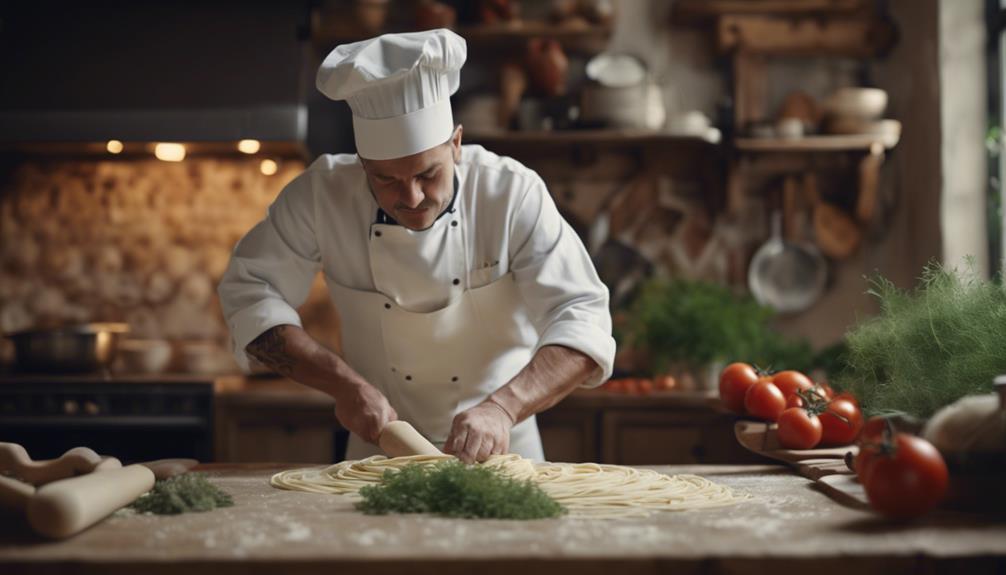
When delving into Northern Italian cuisine, understanding the intricate cooking techniques employed in the region reveals the true essence of its culinary artistry. Here are some key aspects that define the cooking methods in Northern Italy:
- Meticulous Cooking: Northern Italian cuisine values precision and attention to detail in every step of the cooking process, ensuring flavors are perfectly balanced.
- Culinary Craftsmanship: The region prides itself on culinary craftsmanship, emphasizing the artistry of preparation to elevate dishes to a new level of sophistication.
- Traditional Methods: Northern Italy's culinary heritage is preserved through the use of traditional cooking methods that have been passed down through generations, adding depth and authenticity to the cuisine.
- Creamy Texture: Techniques like slow-cooking risotto exemplify the region's commitment to achieving a creamy texture in dishes, showcasing the culinary expertise that sets Northern Italian cuisine apart.
Influences on Northern Italian Cuisine
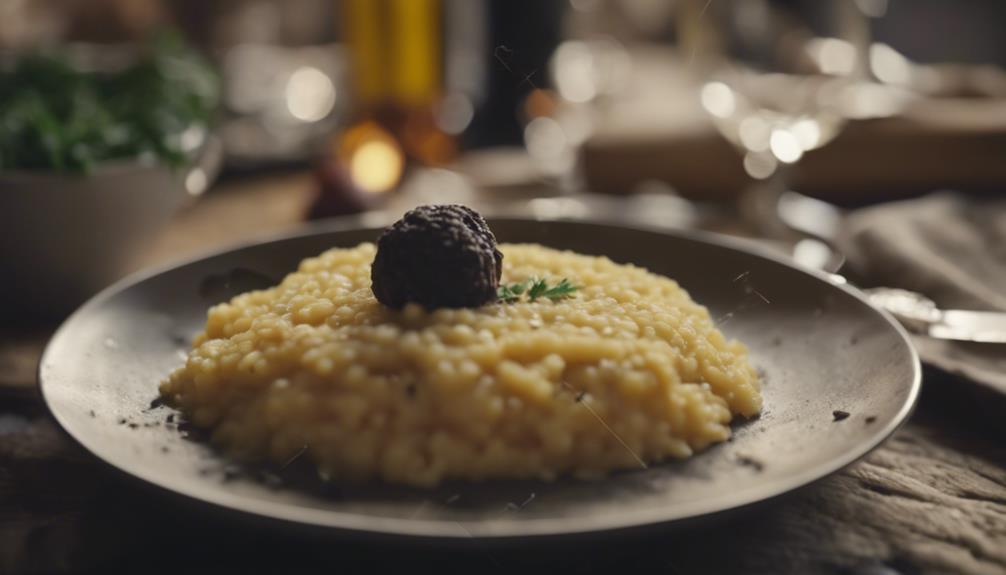
Incorporating the bountiful harvest of the Po Valley, Northern Italian cuisine draws heavily on the region's fertile soil for a rich array of fresh ingredients. The emphasis on locally sourced ingredients enhances the flavors of dishes, providing a burst of freshness that characterizes the culinary artistry of the region. Northern Italian cuisine showcases meticulous preparation techniques passed down through generations, reflecting a deep-rooted appreciation for the craft of cooking.
Iconic cheeses such as Parmigiano-Reggiano and Gorgonzola play a significant role in Northern Italian cuisine, infusing dishes with depth and complexity. These cheeses are a delight for cheese enthusiasts, offering a variety that caters to those who appreciate the art of cheese-making.
The Po Valley's fertile lands not only contribute to the abundance of ingredients but also serve as a foundation for the culinary traditions that have shaped Northern Italian cuisine into a haven for cheese lovers.
Modern Trends in Northern Italian Cooking
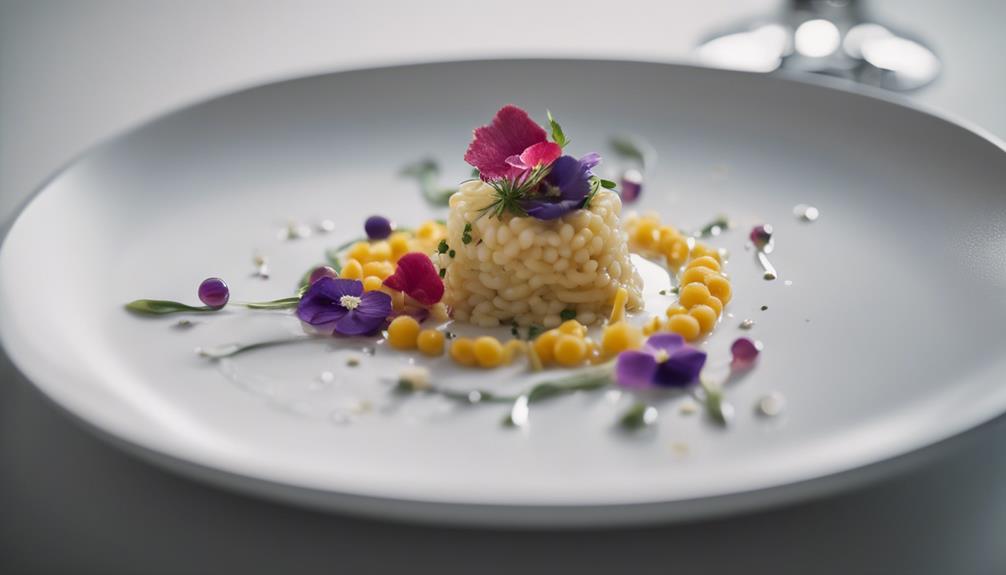
Northern Italian chefs are embracing innovative techniques and flavor pairings to elevate traditional dishes to new heights in the world of modern culinary trends.
Chefs in the various regions of Northern Italy are blending traditional flavors with modern twists, creating a harmonious fusion of old and new tastes.
The use of high-quality ingredients such as seasonal produce and artisanal products is a cornerstone of contemporary Northern Italian cooking, ensuring authenticity and freshness in every dish.
Global influences are reshaping the culinary landscape in Northern Italy, with chefs incorporating elements from different cultures to add excitement and diversity to their creations.
In addition to focusing on flavors and ingredients, chefs are also paying close attention to the visual appeal of their dishes, presenting them in artistic and appealing ways to enhance the overall dining experience.
Frequently Asked Questions
What Is the Cuisine of Northern Italy?
To understand the cuisine of Northern Italy, explore dishes like veal specialties, handmade pasta, and iconic cheeses. Discover culinary traditions passed down through generations, focusing on meticulous preparation techniques that showcase the region's love for good food.
How Does Northern Italian Cuisine Differ From Southern Italian Cuisine?
When considering Northern vs. Southern Italian cuisine distinctions, note the butter-rich dishes of the north contrasted with the olive oil-based fare of the south. Veal and hearty meats define the north, while seafood and citrus flavors shine in the south.
Which Flavours Are Traditionally Used in Italian Cuisine?
Italian cuisine traditionally uses a variety of flavors like fresh herbs, tomatoes, garlic, olive oil, and cheeses. These ingredients play a vital role in creating the rich, savory, and aromatic profiles that define Italian dishes.
What Is Unique About Italian Cuisine?
Italian cuisine, like a symphony of flavors, is a culinary journey blending tradition and innovation. From the rustic simplicity of Southern dishes to the refined elegance of the North, each bite tells a story of Italy's rich gastronomic heritage.
What are the similarities and differences between Northern Italian Cuisine and Italian Coastal Cuisine flavors?
When exploring Northern Italian Cuisine, you’ll find rich, creamy flavors like risotto and hearty stews. In contrast, Italian Coastal Cuisine offers fresh seafood and light, citrusy dishes that highlight the region’s access to the sea. Take a culinary journey and discover italian coastal flavors for a taste of the seaside.
Conclusion
To sum up, Northern Italian cuisine offers a rich tapestry of flavors and traditions that have been honed over centuries. With key ingredients like risotto, polenta, and truffles, this cuisine showcases the region's diverse culinary heritage.
Interesting fact: The region of Emilia-Romagna in Northern Italy is known as the 'culinary capital' of Italy, producing renowned dishes like prosciutto di Parma and Parmigiano Reggiano cheese.
So, next time you sit down to a Northern Italian meal, savor the refined flavors and history that this unique cuisine has to offer.
